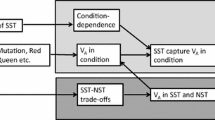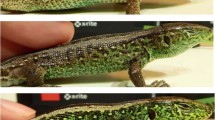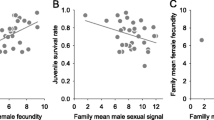Abstract
The adaptive nature of female mate choice remains one of the most contentious issues in the study of sexual selection. Here, I provide evidence that mate choice by females of the ovoviviparous cockroach Nauphoeta cinerea influences the rate at which offspring develop and provides both direct and indirect benefits to the female. Males that are more attractive to females produce offspring with shorter development times than less preferred males. Development time is heritable and apparently unconstrained by antagonistic pleiotropy. Male attractiveness and rate of offspring development are genetically correlated. Offspring gain an indirect benefit from their mother's mate choice because, on average, individuals that hatch faster reach sexual maturity more quickly. Females that discriminate among males gain a direct benefit because N. cinerea is ovoviviparous and the time between clutches is decreased by producing offspring with shorter development. In addition to providing evidence for beneficial consequences of mate choice, this study highlights how genetic data provide insights into the process of sexual selection not gained in a purely phenotypic study.
Similar content being viewed by others
References
Arnold SJ (1985) Quantitative genetic models of sexual selection. Experientia 41: 1296–1310
Arnold SJ, Houck LD (1982) Courtship pheromones: evolution by natural and sexual selection. In: Nitecke M (ed) Biochemical aspects of evolutionary biology. University of Chicago Press, Chicago, pp 173–211
Baker TC, Cardé RT (1979) Courtship behavior of the oriental fruit moth (Grapholitha molesta): experimental analysis and consideration of the role of sexual selection in the evolution of courtship pheromones in the Lepidoptera. Ann Entomol Soc Am 72: 173–188
Bateson P (ed) (1983) Mate choice. Cambridge University Press, Cambridge
Becker WA (1984) Manual of quantitative genetics, 4th edn. Academic Enterprises, Pullman, Washington
Bell WJ, Gorton RE (1978) Informational analysis of agonistic behaviour and dominance hierarchy formation in a cockroach, Nauphoeta cinerea. Behaviour 67: 217–235
Boake CRB ( 1985) Genetic consequences of mate choice: a quantitative genetic method for testing sexual selection theory. Science 227: 1061–1063
Boake CRB (1986) A method for testing adaptive hypotheses of mate choice. Am Nat 127: 654–666
Bradbury JW, Andersson MB (1987) Sexual selection: testing the alternatives. Wiley, New York
Breed MD, Smith SK, Gall BG (1980) Systems of mate selection in a cockroach species with male dominance hierarchies. Anim Behav 28: 130–134
Brossut R, Dubois P, Rigaud J, Sreng L (1975) Etude biochimique de la secretion des glandes tergales des Blattaria. Insect Biochem 5: 719–732
Butlin RK, Hewitt GM (1986) Heritability estimates for characters under sexual selection in the grasshopper, Chorthippus brunneus. Anim Behav 34: 1256–1261
Cheverud JM (1984) Evolution by kin selection: a quantitative genetic model illustrated by maternal performance in mice. Evolution 38: 766–777
Cheverud JM, Moore AJ (1994) Quantitative genetics and the role of the environment provided by relatives in behavioral evolution. In: Boake CRB (ed) Quantitative genetic analyses of behavioral evolution. University of Chicago Press, Chicago, pp 67–100
Conner WE, Eisner T, Vander Meer RK, Guerrero A, Meinwald J (1981) Precopulatory sexual interaction in an arctiid moth (Utetheisa ornatrix): the role of a pheromone derived from dietary alkaloids. Behav Ecol Sociobiol 9: 227–235
Darwin CR (1871) The descent of man and selection in relation to sex. John Murray, London
Eisen EJ (1967) Mating designs for estimating direct and maternal genetic variances and direct-maternal covariances. Can J Genet Cytol 9: 13–22
Ewing LS (1972) Hierarchy and its relation to territoriality in the cockroach Nauphoeta cinerea. Behaviour 42: 152–173
Ewing LS (1973) Territoriality and the influence of females on the spacing of males in the cockroach Nauphoeta cinerea. Behaviour 45: 281–304
Ewing LS, Ewing AW (1973) Correlates of subordinate behaviour in the cockroach, Nauphoeta cinerea. Anim Behav 21: 571–578
Falconer DS (1989) Introduction to quantitative genetics, 3rd edn. Wiley, New York
Fisher RA (1915) The evolution of sexual preference. Eugen Rev 7: 184–192
Fisher RA (1958) The genetical theory of natural selection, 2nd edn. Dover, New York
Fukui M, Takahashi S (1983) Studies on the mating behavior of the cockroach Nauphoeta cinerea (Olivier) (Dictyoptera: Blaberidae) III. Isolation and identification of intermale recognition pheromone. Appl Entomol Zool 18: 351–356
Hedrick AV (1988) Female choice and the heritability of attractive male traits: an empirical study. Am Nat 132: 267–276
Heisler IL (1994) Quantitative genetic models of the evolution of mating behavior. In: Boake CRB (ed) Quantitative genetic analyses of behavioral evolution. University of Chicago Press, Chicago, pp 101–125
Heywood JS (1989) Sexual selection by the handicap mechanism. Evolution 43: 1387–1397
Hill GE (1991) Plumage coloration is a sexually selected indicator of male quality. Nature 350: 337–339
Houde AE (1992) Sex-linked heritability of a sexually selected character in a natural population of Poecilia reticulata (Pisces: Poeciliidae) (guppies). Heredity 69: 229–235
Kirkpatrick M (1987) Sexual selection by female choice in polygynous animals. Annu Rev Ecol Syst 18: 43–70
Kirkpatrick M, Lande R (1989) The evolution of maternal characters. Evolution 43: 485–503
Kirkpatrick M, Ryan MJ (1991) The evolution of mating preferences and the paradox of the lek. Nature 350: 33–38
Lande R, Kirkpatrick M (1990) Selection response in traits with maternal inheritance. Genet Res Camb 55: 189–197
Lynch M (1987) Evolution of intrafamilial interactions. Proc Natl Acad Sci USA 84: 8507–8511
Manly BFJ (1991) Randomization and Monte Carlo methods in biology. Chapman and Hall, London
Maynard Smith J (1991) Theories of sexual selection. Trends Ecol Evol 6: 146–151
McLain DK (1987) Heritability of size, a sexually selected character, and the response to sexual selection in a natural population of the southern green stink bug, Nezara viridula (Hemiptera: Pentatomidae). Heredity 59: 391–395
Menon M (1981) Morphological evidence for probable secretory site for the pheromone “seducin” in males of Nauphoeta cinerea. I. Light microscope studies. J Morphol 168: 229–237
Menon M (1986) Morphological evidence for probable secretory site of the male sex pheromones of Nauphoeta cinerea (Blateria, Blaberidae). 2. Electron microscope studies. J Morphol 187: 69–79
Møller AP (1991) Viability is positively related to degree of ornamentation in male swallows. Proc R Soc Lond B 243: 145–148
Moore AJ (1988) Female preferences, male social status, and sexual selection in Nauphoeta cinerea. Anim Behav 36: 303–305
Moore AJ (1990a) The inheritance of social dominance, mating behaviour and attractiveness to mates in male Nauphoeta cinerea. Anim Behav 39: 388–397
Moore AJ (1990b) Sexual selection and the genetics of pheromonally mediated social behavior in Nauphoeta cinerea (Dictyoptera: Blaberidae). Entomol Gener 15: 133–147
Moore AJ, Breed MD (1986) Mate assessment in a cockroach, Nauphoeta cinerea. Anim Behav 34: 1160–1164
Moore AJ, Moore PJ (1988) Female strategy during mate choice: threshold assessment. Evolution 42: 387–391
Moore AJ, Reagan NR, Haynes KF (in press) Conditional signalling strategies: effects of ontogeny, social experience, and social status on the pheromonal signal of male cockroaches, Nauphoeta cinerea. Anim Behav (in press)
Mullins DE, Kiel CB (1980) Paternal investment of urates in cockroaches. Nature 283: 567–569
Norris K (1993) Heritable variation in a plumage indicator of viability in male great tits Parus major. Nature 362: 537–539
O'Donald P (1990) Fisher's contributions to the theory of sexual selection as the basis of recent research. Theor Popul Biol 38: 285–300
Petrie M, Williams A (1993) Peahens lay more eggs for peacocks with larger trains. Proc R Soc Lond B 251: 127–131
Phelan PL, Baker TC (1986) Male-size related courtship success in intersexual selection in the tobacco moth, Ephestia elutella. Experientia 42: 1291–1293
Pomiankowski AN (1988) The evolution of female mate preferences for male genetic quality. Oxford Surv Evol Biol 5: 136–184
Price T, Schluter D, Heckman NE (1993) Sexual selection when the female directly benefits. Biol J Linn Soc 48: 187–211
Roth LM (1962) Hypersexual activity induced in females of the cockroach Nauphoeta cinerea. Science 138: 1267–1269
Roth LM (1964a) Control of reproduction in female cockroaches with special reference to Nauphoeta cinerea. I. First pre-oviposition period. J Insect Physiol 10: 915–945
Roth LM (1964b) Control of reproduction in female cockroaches with special reference to Nauphoeta cinerea. II. Gestation and postparturition. Psyche 71: 198–244
Roth LM (1967) Uricose glands in the accessory sex gland complex of male Blattaria. Ann Entomol Soc Am 60: 1203–1211
Roth LM, Barth RH (1967) The sense organs employed by cockroaches in mating behavior. Behaviour 28:58–94
Roth LM, Dateo GP (1966) A sex pheromone produced by males of the cockroach Nauphoeta cinerea. J Insect Physiol 12:255–265
Roth LM, Hahn W (1964) Size of new-born larvae of cockroaches incubating eggs internally. J Insect Physiol 10:65–72
Roth LM, Willis ER (1958) An analysis of oviparity and viviparity in the Blatteria. Trans Am Entomol Soc 83:221–238
Schal C, Bell WJ (1983) Determinants of dominant-subordinate interactions in males of the cockroach Nauphoeta cinerea. Biol Behav 8:117–139
Simmons LW (1987a) Female choice contributes to offspring fitness in the field cricket, Gryllus bimaculatus (De Geer). Behav Ecol Sociobiol 21:313–321
Simmons LW (1987b) Heritability of a male character chosen by females of the field cricket, Gryllus bimaculatus. Behav Ecol Sociobiol 21:129–133
Sirugue D, Bonnard O, LeQuere J-L, Farine J-P, Brossut R (1992) 2-methylthiazolidine and 4-ethylguaiacol, male sex pheromone components of the cockroach Nauphoeta cinerea (Dictyoptera, Blaberidae): a reinvestigation. J Chem Ecol 18:2261–2276
Smith SK, Breed MD (1982) Olfactory cues in discrimination among individuals in dominance hierarchies in the cockroach, Nauphoeta cinerea. Physiol Entomol 7:337–341
Sreng L (1984) Morphology of the sternal and tergal glands producing the sexual pheromones and the aphrodisiacs among the cockroaches of the subfamily Oxyhaloinae. J Morphol 182:279–284
Sreng L (1985) Ultrastructure of the glands producing sex pheromones of the male Nauphoeta cinerea (Insecta: Dictyoptera). Zoomorphology 105:133–142
Sreng L (1990) Seducin, male sex pheromone of the cockroach Nauphoeta cinerea: isolation, identification, and bioassay. J Chem Ecol 16:2899–2912
Thornhill R, Alcock J (1983) The evolution of insect mating systems. Harvard University Press, Cambridge
Von Schantz T, Göransson G, Andersson G, Fröberg I, Grahn, M, Helgée A, Wittzell H (1989) Female choice selects for a viability-based male trait in pheasants. Nature 337: 166–169
Willis ER, Riser GR, Roth LM (1958) Observations on reproduction and development in cockroaches. Ann Entomol Soc Am 51: 53–59
Williams GC (1992) Natural selection. Oxford University Press, Oxford
Author information
Authors and Affiliations
Additional information
Communicated by P. Pamilo
Rights and permissions
About this article
Cite this article
Moore, A.J. Genetic evidence for the “good genes” process of sexual selection. Behav Ecol Sociobiol 35, 235–241 (1994). https://doi.org/10.1007/BF00170703
Received:
Accepted:
Issue Date:
DOI: https://doi.org/10.1007/BF00170703




